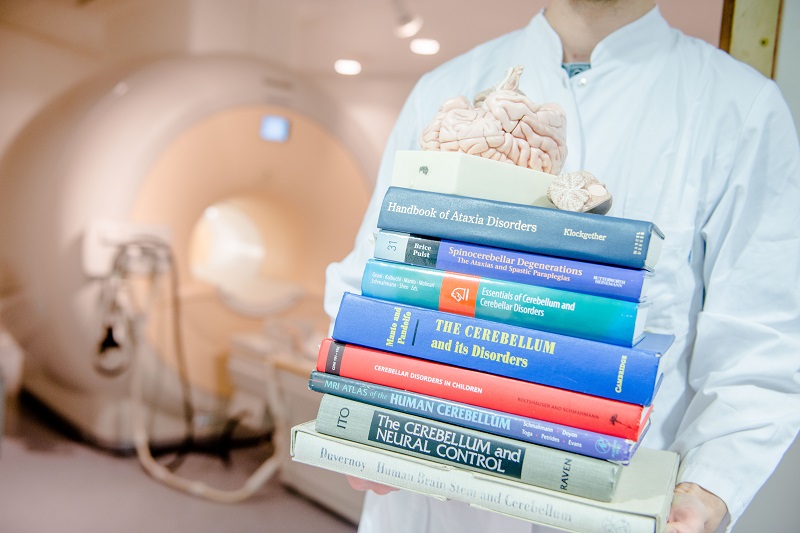
A05 – The contribution of the cerebellum to extinction: intrinsic mechanisms and cerebello-cerebral interactions
Dagmar Timmann-Braun, Harald H. Quick
Project A05 includes three 7T fMRI studies, two 3T fMRI studies and one behavioral study. Two of the 7T fMRI experiments (study 1 and 2) will be performed in the first two years of funding. The behavioral study (study 5) will start during the first year. The 3T fMRI experiments (study 3 and 4) will start in the second year. Study 3 makes use of the optimized cerebellar tDCS parameters established in the first year in A06. Study 4 will be performed in cerebellar patients. We expect data acquisition of studies 3–5 to be finished by the end of the third year. In the fourth year the tDCS set-up will be brought to the 7T MR scanner (study 6).
Guiding questions of A05:
- Does the human cerebellum, more specifically the cerebellar vermis and the fastigial nuclei, contribute to the extinction of conditioned fear?
- What are the intrinsic cerebellar mechanisms underlying extinction?
- Does the cerebellum interact with cerebral areas, in particular the amygdala, hippocampus and prefrontal cortex, during extinction?
- Do the posterolateral cerebellar hemispheres and vermis play a different role in extinction?
- Can the proposed intrinsic cerebellar mechanisms and cerebello-cerebral interactions be modulated by cerebellar transcranial direct current stimulation (tDCS) and by cerebellar dependent motor learning?

10 project-relevant publications
Batsikadze G, Diekmann N, Ernst TM, Klein M, Maderwald S, Deuschl C, Merz CJ, Cheng S, Quick HH, Timmann D (2022) The cerebellum contributes to context-effects during fear extinction learning: A 7T fMRI study. Neuroimage 253:119080. https://doi.org/10.1016/j.neuroimage.2022.119080
Batsikadze G, Pakusch J, Klein M, Ernst TM, Thieme A, Nicksirat SA, Steiner KM, Nio E, Genç E, Maderwald S, Deuschl C, Merz CJ, Quick HH, Mark MD, Timmann D (2024) Mild Deficits in Fear Learning: Evidence from Humans and Mice with Cerebellar Cortical Degeneration. eNeuro 11. https://doi.org/10.1523/ENEURO.0365-23.2023
Doubliez A, Koster K, Muntefering L, Nio E, Diekmann N, Thieme A, Albayrak B, Nicksirat SA, Erdlenbruch F, Batsikadze G, Ernst TM, Cheng S, Merz CJ, Timmann D (2025) Dopaminergic drugs modulate fear extinction related processes in humans, but effects are mild. bioRxiv. https://doi.org/10.1101/2025.04.11.648372
Englert R, Kincses B, Kotikalapudi R, Gallitto G, Li J, Hoffschlag K, Woo C-W, Wager TD, Timmann D, Bingel U, Spisák T (2023) Connectome-Based Attractor Dynamics Underlie Brain Activity in Rest, Task, and Disease. eLife13:RP98725. https://doi.org/10.7554/eLife.98725
Ernst TM, Brol AE, Gratz M, Ritter C, Bingel U, Schlamann M, Maderwald S, Quick HH, Merz CJ, Timmann D (2019) The cerebellum is involved in processing of predictions and prediction errors in a fear conditioning paradigm. Elife 8. https://doi.org/10.7554/eLife.46831
Inoue L, Ernst TM, Ferber II, Merz CJ, Timmann D, Batsikadze G (2020) Interaction of Fear Conditioning with Eyeblink Conditioning Supports the Sensory Gating Hypothesis of the Amygdala in Men. eNeuro 7. https://doi.org/10.1523/eneuro.0128-20.2020
Mark MD, Pakusch J, Ernst TM, Timmann D (2022) Cerebellum and Emotion Memory. Adv Exp Med Biol 1378:53–73. https://doi.org/10.1007/978-3-030-99550-8_5
Nio E, Pereira PP, Diekmann N, Petrenko M, Doubliez A, Ernst TM, Batsikadze G, Maderwald S, Deuschl C, Üngör M, Cheng S, Merz CJ, Quick HH, Timmann D (2025) Human cerebellum and ventral tegmental area interact during extinction of learned fear. eLife 14:RP105399. https://doi.org/10.7554/eLife.105399
Petrenko M, Coenen L, Doubliez A, Ernst TM, Nio E, Diekmann N, Uengoer M, Cheng S, Merz CJ, Timmann D, Batsikadze G (2025) Appetitive and aversive classical conditioning: Self-reports and physiological responses. Behav Brain Res 484:115509. https://doi.org/10.1016/j.bbr.2025.115509
Thieme A, Spisák Z, Zeidan P, Klein M, Nio E, Ernst TM, Diekmann N, Göricke S, Cheng S, Merz CJ, Yavari F, Nitsche MA, Batsikadze G, Timmann D (2025) Cerebellar transcranial alternating current stimulation in the theta band facilitates extinction of learned fear responses. bioRxiv:2025.01.13.632735. https://doi.org/10.1101/2025.01.13.632735





